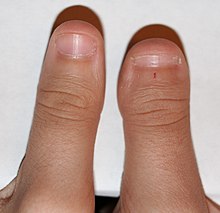Brachydactyly type D: Difference between revisions
m Reverted edits by 72.77.116.80 (talk) (HG) (3.4.4) |
No edit summary Tags: Mobile edit Mobile web edit |
||
| Line 24: | Line 24: | ||
'''Stub thumb'''<ref name="Goodman et al 1965">{{cite journal |pmid=14295653 |pmc=1012845 |year=1965 |author1=GOODMAN RM |title=A Genetic Study of Stub Thumbs Among Various Ethnic Groups in Israel |journal=Journal of Medical Genetics |volume=2 |issue=2 |pages=116–21 |author2=ADAM A |author3=SHEBA C }}</ref> is a condition clinically recognised by a [[Thumb|thumb]] being relatively short and round with an accompanying wide [[Nail (anatomy)|nail]] bed as the [[distal phalanx]] of affected thumbs is approximately two-thirds of full-length thumbs. Classified as [[brachydactyly]] type D, this [[Human skeleton|skeletal]] [[Deformity|variation]] is associated with the [[HOXD13]] gene. |
'''Stub thumb'''<ref name="Goodman et al 1965">{{cite journal |pmid=14295653 |pmc=1012845 |year=1965 |author1=GOODMAN RM |title=A Genetic Study of Stub Thumbs Among Various Ethnic Groups in Israel |journal=Journal of Medical Genetics |volume=2 |issue=2 |pages=116–21 |author2=ADAM A |author3=SHEBA C }}</ref> is a condition clinically recognised by a [[Thumb|thumb]] being relatively short and round with an accompanying wide [[Nail (anatomy)|nail]] bed as the [[distal phalanx]] of affected thumbs is approximately two-thirds of full-length thumbs. Classified as [[brachydactyly]] type D, this [[Human skeleton|skeletal]] [[Deformity|variation]] is associated with the [[HOXD13]] gene. |
||
Jamie booth has wide thumb coz he is a nut. |
|||
== Term == |
== Term == |
||
Revision as of 14:26, 15 May 2019
| Brachydactyly type D | |
|---|---|
 | |
| Child's thumbs with unilateral brachydactyly type D (with bitten nails giving the shortness a more extreme appearance than normally-treated nails) | |
| Specialty | Medical genetics |
Stub thumb[1] is a condition clinically recognised by a thumb being relatively short and round with an accompanying wide nail bed as the distal phalanx of affected thumbs is approximately two-thirds of full-length thumbs. Classified as brachydactyly type D, this skeletal variation is associated with the HOXD13 gene.
Jamie booth has wide thumb coz he is a nut.
Term
Stub thumbs are medically classified as brachydactyly type D (BDD) alias brachymegalodactylism.[1][2] Coined by R.A. Hefner in 1924, 'stub thumb' is a scientifically preferred term used to identify brachydactyly type D.[1][2] Stub thumbs have also been called murderer's thumb (allegedly among fortune tellers)[1], bohemian thumb, and potter's thumb.[2]
Physics
Brachydactyly type D is a skeletal condition allegedly caused by a 'partial fusion or premature closing of the epiphysis with the distal phalanx of the thumb', according to Goodman et alia (1965). J.K. Breithenbecher (1923) found that distal phalanges of stub thumbs were one-half the length of full-length thumbs, while R.M. Stecher (1957) claimed that it be approximately two-thirds. The condition may either be unilateral (affecting one thumb) or bilateral (affecting both).[1]
Genetics
A genetic trait, brachydactyly type D exhibits autosomal dominance and is commonly developed or inherited independently of other hereditary traits. The condition is associated with the HOXD13 gene, which is central in digital formation and growth.[2]
References
- ^ a b c d e GOODMAN RM; ADAM A; SHEBA C (1965). "A Genetic Study of Stub Thumbs Among Various Ethnic Groups in Israel". Journal of Medical Genetics. 2 (2): 116–21. PMC 1012845. PMID 14295653.
- ^ a b c d McKusick, Victor A. 'Brachydactyly, Type D; BDD'. Online Mendelian Inheritance in Man. Retrieved on 2 May 2018. https://omim.org/entry/113200
